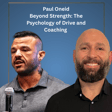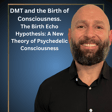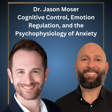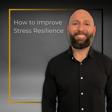Become a Creator today!Start creating today - Share your story with the world!
Start for free
00:00:00
00:00:01

The Biopsychosocial Model for Mental Health
In this episode I explore the use of The Biopsychosocial Model for Mental Health. I break down each component of the model exploring the validity of biological, psychological, and social interventions. I go over the research comparing this model to single treatment options. Why the US health care system has not adopted yet and future directions on how we can push it into the US health care hemisphere for adoption.
Transcript
Introduction to the Biopsychosocial Model
00:00:00
Tony Montgomery
Today we're going to go over the biopsychosocial model of mental health treatment and kind of parse out why this should be the model that is adopted by the the US and and how some of the other global powers have have adopted it and and how it compares to the other models that are out there.
00:00:23
Tony Montgomery
So this was a model that was first proposed by George Engel in 1977. So it's ah fairly new model when it comes to mental health care. and and the idea that it looks at the complexity of these mental health disorders from a biological standpoint, which we've um covered, um and but also the psychological and the the social component of it.
00:00:47
Tony Montgomery
um So it no longer looks at mental health disorders as a a disruption of purely the biology and um focuses more on um the other outcomes that that
Understanding Mental Health Disorders Through the Model
00:01:00
Tony Montgomery
matter. and And we'll dive into that a little bit more. And we'll also talk about why this biological component took shape and and why it became so successful and and it still is prevalent today within the the research and within the um within the care units. um So the the idea is that we're we're focusing on
00:01:25
Tony Montgomery
um a model ah as a person as as a whole right and and the person um is not someone that suffers in in isolation of of certain organ parts, but rather as the mind body and the the environment and And we look at this idea as these these three domains and then how can we how can we put those together in a comprehensive way that makes it um a successful healthcare program for for people that do suffer from mental health disorders.
00:02:01
Tony Montgomery
And the over the past decades, the this model, this biopsychosocial model or BPS model um for short, has been a a theory that's been widely accepted and used as a guiding framework and understanding of mental health disorders.
00:02:18
Tony Montgomery
And every major health condition can be analyzed through this lens. um So depression might involve a genetic vulnerability um or a neurotransmitter imbalance, um which those are kind of like the biological sides of things. um So those things do matter.
00:02:34
Tony Montgomery
And pharmacology is important and for some people and and for a lot of people. And um But then you have the psychological component of depression, which is negative thought patterns, this rumination, this this worry, and or or trauma.
00:02:47
Tony Montgomery
um And then you have the social isolation component, right, and were or poverty like that. Those are the social dynamics of
Critique of Singular Approaches
00:02:55
Tony Montgomery
it. So, so that's kind of the lens we're starting to look at where a Purely like biomedical, biological approach is going to be thinking more along the lines of um medication only, SSRIs, how can we improve um that dynamic and and then and then move on?
00:03:11
Tony Montgomery
um Or the the psychological component, which is just therapy, therapy only, either some kind of cognitive behavioral therapy or psychoanalytic therapy. And by focusing on the singularity of those things instead of the whole, we start to miss these critical pieces.
00:03:29
Tony Montgomery
And so so we're thinking about like comprehensive care, um trying to combine interventions of medication, psychotherapy and social support.
Biological Factors and Interventions
00:03:38
Tony Montgomery
And then what programs can we establish that allows us to to do that and in the U.S.?
00:03:44
Tony Montgomery
um So some of the things to to think about in terms of biological factors is this physiological or genetic underpinnings of of mental health, right? that's the That's the biological component of it. um So the the heritable risk factors, ah the brain structures and neurotransmitters that that go into um these mental health disorders, the hormones, of physical health conditions, and and other bodily processes.
00:04:13
Tony Montgomery
um So an overactivity of the amygdala might heighten the anxiety response or a polymorphism in serotonin transport genes. um might predispose someone to depression.
00:04:25
Tony Montgomery
And many serious mental health illnesses have um demonstrable biological components to them ah through neural circuit dysfunction, dysregulation, or neurotransmitter imbalances.
00:04:38
Tony Montgomery
And these biological components are extremely important powerful and and worth looking into. um So this is not to necessarily knock that component of things, but we also want to figure out like why the shift has has been from um purely focusing on the the biological side. And I think with the advent of of neuroscience that allows us to dive deeper into the brain and come up with some ideas of of what we can build and and how we can facilitate that.
00:05:08
Tony Montgomery
And um some of the the the reasons why it is so powerful is is a lot of times it can and it's been proven to save people's lives and and give people opportunities to overcome um some of these mental health disorders so it's not necessarily a native thing but it does come with with side effects so we have to keep those things in mind um so biological interventions Those are treatments that act on the body's physical systems or chemistry in mental health care, um the most common being the pharmacological side of things with antidepressants, medications like SSRIs.
00:05:45
Tony Montgomery
to adjust the serotonin that's in in the brain or the norepinephrine that's in the brain. and There's also mood stabilizers like lithium um for bipolar disorders to regulate neural excitability.
00:05:59
Tony Montgomery
And then there's the antipsychotic drugs for schizophrenia and psychotic disorders targeting dopamine pathways and the anxiolytic drugs to help with anxiety and and panic attacks.
Psychological Treatments and Their Role
00:06:12
Tony Montgomery
so some other biological treatments that have been shown to be very effective is the electroconvulsive therapy for severe depression and transmagnetic stimulation so transcranial magnetic stimulation repetitive tms for depression has emerged as a very viable tool fda approved and but that allows us to um you know help people without going into these neurotransmitter pathways. And the reason why transcranial magnetic stimulation works and and one of the reasons why it tends to push away from this idea that neurotransmitters are the are the key driver and these um it's like these pharmacological interventions that target neurotransmitters that come with these negative side effects aren't necessarily something that has to be done with the transcranial magnetic stimulation.
00:07:02
Tony Montgomery
we see that we can improve um depression in people and it has nothing to do with with serotonin. and And it typically has to do with um when you see it being used, it's used in most of the time it's used on the left dorsolateral prefrontal cortex.
00:07:21
Tony Montgomery
And they do these interventions of you know anywhere between 4,000, 5,000 stimulations over a five-day period.
00:07:31
Tony Montgomery
And it's pretty aggressive. And that's been shown to have like 80 85% rate of reducing depression. And rate of reducing depression and The reason is, is because in that in that left hemisphere, that's very much the excitability hemisphere, it's more of a positive a effect hemisphere, not excitability, but positive effect, whereas the right hemisphere is more negative effects. So you can imagine people with depression, that positive effect tends to get blunted.
00:08:04
Tony Montgomery
And what the transcranial magnetic stimulus does is it helps to excite those areas again and make it more of a tangible thing to um get towards that positive effect without actually inducing a lot of neurotransmitters. So the idea is that there's all these biological components and some other interventions we could think about is adequate sleep, nutrition, exercise.
00:08:30
Tony Montgomery
Those are things that can help from a biological standpoint. um So, and then we get into this idea of what are some of the psychological treatments? What are some of the psychological interventions? And the reason we're covering it this way is because it's going allow us to understand what the research shows when they do these combinations of um pharmacological with cognitive behavioral therapy or exercise with cognitive behavioral therapy compared to um one or the other by themselves and and why there is such an improvement.
00:09:05
Tony Montgomery
So the biopsychosocial model, it does caution that biological treatment alone may not lead to full recovery, especially if psychological or social drivers of the illness remain on undressed, right? So think of it in terms of we can we can give somebody these pharmacological pills, these interventions, and that can help with the plasticity in the brain and create these new neurotransmitters to be readily accessible within the brain.
00:09:33
Tony Montgomery
But if the environment that the person lives in is what's causing the stress and we're not able to take them out of that environment, then those pills are not going to do anything for for that stressful environment that's creating the problem in the first place.
00:09:48
Tony Montgomery
Or any time they come up with some type of negative stimulus, because they haven't gone to therapy, they don't have the tools to overcome them. And that's why we see a lot of times with these purely pharmacological interventions that there's a high relapse rate um due to one that about 50% of people do not take the medication they're prescribed, but also because they're not able to have the tools or they're not able to get out of the environment.
00:10:19
Tony Montgomery
That's the thing that's causing the mental health disorder. It's not just this dysregulation. um So some of the psychological interventions and factors, right, that that encompasses the internal process of the mind that influences the mental health of of the individuals. And these include an individual's thoughts, emotions, behaviors, personality traits, coping skills, belief, past experiences such as trauma or adverse childhood events.
00:10:47
Tony Montgomery
um one thing to think of is like persistent negative thinking patterns or maladaptive beliefs like i'm worthless or catastrophizing thinking um thinking that the worst is going to come no matter what the situation is no matter how good things are coming you know that the it's going to blow up there's going to be something negative and that's these um thought patterns um my advisor Dr. Grant, he works a lot in looking at the role of anxiety and negative thoughts and these ruminative patterns and and how they correlate to different areas of the brain but through EEG, but also how they um mediate each other and how they interact with each other.
00:11:32
Tony Montgomery
So he does really good research on that. and what what we find is that these things contribute to depression and these thought patterns aren't necessarily something that we can fix through ah pharmacological interventions only. We need to give people the tools through talk therapy, dialectical behavior therapy, cognitive behavioral therapy so that they can overcome it.
00:11:55
Tony Montgomery
um But one of the downsides of that is that you're trying to give somebody these tools to do the work and it is work they have to be able to put in just like going to the gym you go to the gym 20 30 minutes a day and you do that your entire life and then you take you know six months off you'll see a deterioration in um the muscle and the strength that you put on or your aerobic fitness it's the same thing with these behavioral tools that they are taught through therapy like you have to train them
00:12:26
Tony Montgomery
often and trying to get somebody who's depressed or anxious, these tools to train is very difficult. So you can see why if we hey if we add the pharmacological component to it, that's going allow them to improve their mood.
00:12:42
Tony Montgomery
And then that may give them the energy to do the cognitive behavioral therapy interventions that we're um proposing that they do. So you can see the balance and the interaction and the the interwovenness that can be very successful in this biopsychosocial model.
00:12:58
Tony Montgomery
um So also thinking about the psychological component, right, they have a history of trauma can induce psychological conditions like PTSD, or influence how someone handles stress psychological factors also covered.
00:13:12
Tony Montgomery
um Also cover learned behaviors and condition responses. um So like avoidance behaviors or or phobias, that's not something that we can overcome through pharmaceuticals. We have to do the interventions to improve that fear response through um the inoculation of continuing to expose them to small intricacies of the fear.
00:13:34
Tony Montgomery
And that allows them to improve over time. And we can see why that happens due to um a blunt in of the amygdala response. And then some of the talk therapies that they have going on is cognitive behavioral therapy, and that helps patients identify and reframe negative thought patterns. I use this a lot in the research that I do, as far as like cognitive reappraisal and reframing negative thought patterns.
00:13:59
Tony Montgomery
And then those things can gradually change unhelpful behaviors over time. But it is something that they have to practice. It's a daily, almost like a daily meditative practice that they have to work on. They have a lot of worksheets and they get the job done, but you have to make sure that you're able to put in the work.
00:14:16
Tony Montgomery
um So it's effective. It's been shown to be effective for a depression, anxiety disorders, PTSD. um Then there's dialectical behavior therapy. It's a form of cognitive behavioral therapy.
00:14:28
Tony Montgomery
It's more of a a talk therapy, um hence the phrase dialectic. And this is useful for borderline personality disorders, focusing on emotion regulation and distress tolerance. And then there's the psychoanalytic therapy that was famously coined by Freud and and Carl Jung.
00:14:47
Tony Montgomery
And this explores this unconscious conflict and past experience that may be contributing to the current problem. So you're able to dive deeper into the unconscious um and what what could be causing that through um childhood trauma or any any other instances of of a type of of trauma.
00:15:07
Tony Montgomery
And then there are these trauma-focused therapies such as eye movement desensitization and reprocessing. um which has been shown to be effective, even though we are not sure why it's effective, but it has been shown to be effective.
00:15:22
Tony Montgomery
um But there's also trauma-focused CBT as well. So CBT has very specific areas that it focuses on addressing traumatic memories and their psychological impact. And that's why we see things like the psychedelics being such a useful tool for a lot of people when it comes to overcoming PTSD, something like MDMA or ecstasy.
00:15:50
Tony Montgomery
is one of those things that when used with therapy allows you to explore those traumatic experiences in a heightened state of of love and and arousal.
00:16:05
Tony Montgomery
So it makes it a safe place for you to do that. And they do that with therapists. So they're able to take them on this journey to overcome this traumatic experience and create a new valence for it and also give them a sense of control over it um so even within those therapeutic settings we see that there is a drug component with an intervention component and that seems to be far more effective for people that suffer from PTSD than some of these other things. And and hopefully through the process of continuing to do the research, it'll get FDA approved, and then we'll be able to do even more research and get it out to more people.
00:16:41
Tony Montgomery
um And then there's behavioral therapy is like exposure therapy that we just talked about for phobias or obsessive compulsive disorder. And that's gradually confronting feared stimuli to reduce anxiety or behavioral activation for depression, scheduling meaningful activities to comb combat with withdrawal.
00:16:59
Tony Montgomery
um And then there's family or couples therapy that helps address an interpersonal dynamics um that affect the individual's mental health and um some other interventions that have been shown to be effective in the psychological components like the psychoeducation
Impact of Social Factors on Mental Health
00:17:15
Tony Montgomery
idea. and And that's one of the reasons that I wanted to do this podcast is that the more education you have, the more you're able to um condition to a fault, like you're able to foster an understanding and have better coping strategies.
00:17:30
Tony Montgomery
And then there's stress management techniques like meditation, mindfulness, relaxation training, and then social skills, problem solving skills, training, and then peer support or counseling, right? The aim is to help the individual develop healthier thought patterns, emotional responses, and behaviors um to negative stimuli or even positive stimuli.
00:17:51
Tony Montgomery
um In many cases, psychological interventions have been shown to significantly improve symptoms and functions um cognitive and family therapists and schizophrenia can reduce relapse rates when combined with medication and depression and anxiety psychotherapy can be as effective as medication and a combination often works best and then getting into like the social environmental factors uh for um this component and then what do those interventions look like so the social factors there cover a broad context in which individuals lives and
00:18:25
Tony Montgomery
external triggers um or supports that affect mental health. The categories are relationship-based, so family family dynamics, marital status, friendships, social support network, community, cultural influences, um education, employment status,
00:18:44
Tony Montgomery
um economic stability, environmental stressors, resources and and resources, environmental resources, and the key social determinants like poverty, unemployment, lack of housing, discrimination, trauma, violence, exposure are well known to increase risk um for mental health problems uh something we talked about in previous episodes is this idea and and we talked about this with dr um ads head as well is that there's there's all of these little components that add up and if we're not able to tackle them one by one and combine them together um then the person's never fully going to get as as healthy as they they can be um so we know that
00:19:26
Tony Montgomery
in utero ah babies that have stressed mothers due to low socioeconomic status has a heightened response to fear and and negative stimuli because their amygdala comes out um when they're born their amygdala is enlarged and their prefrontal cortex is is smaller and that transcends throughout their entire life um And they've done really good research to to showcase that. So we do know that the social component plays a huge factor in mental health disorders. And some of the interventions that they do um kind of translate into the psychological component. But as you you'll see that there's a tangible difference to them. Family therapy and psychoeducation, which we kind of touched on.
00:20:14
Tony Montgomery
um This is the idea that we bring the entire family in on ah in the treatment and we're educating them about the illness improving family communication has been shown to reduce relapse in disorders like schizophrenia and bipolar disorder.
00:20:28
Tony Montgomery
You can imagine by having this education system put in place that the families can see the signs and symptoms happening and they can understand it so that they can combat it before it actually gets magnified into a full-on manic state or um something along those lines right so and then there could be that miscommunication of like hey you you don't understand what i'm going through um because you've never gone through this, so therefore how can you help me work through this problem?
00:20:59
Tony Montgomery
So by having that education can be very powerful. There's peer support groups such as ah PTSD groups, 12-step support groups for substance abuse, and this provides support, reduces isolation, and helps people learn coping strategies um from their peers that have have that lived and shared experience.
00:21:20
Tony Montgomery
um Supported employment and education programs that help those with serious mental illnesses find and maintain meaningful work or continue schooling. um Evidence shows that supported employment such as individual placement or support models um can dramatically improve vocational outcomes for people with conditions like schizophrenia, which in turn improves self-esteem and social integration into that community.
00:21:43
Tony Montgomery
And then housing and community support, things like assertive community treatment teams, um actively help individuals live in the community instead of hospitals or jails. um The social component, as you can see, it's like it provides the sense of of hope that, hey, there there is something out there. There are people that care about me.
00:22:03
Tony Montgomery
um But also there's these things put in place that if I do get this under control, I have options to live a more fulfilling and meaningful life.
00:22:15
Tony Montgomery
um And what they found within the research with these assertive community treatment teams um that reduce it reduces homelessness in the populations that that it works in by up to 37% and is more satisfactory to patients than the standard care that they've that they've normally got.
00:22:33
Tony Montgomery
um And then there's social skills and rehabilitation, and that can help those with schizophrenia improve that interpersonal functioning and psychological and psychiatric rehabilitation programs often encompasses vocational training. So they're teaching them a craft, they're teaching them a job, life skills, coaching, recreational activities, right? So they're around other people, they're having fun, they're engaging in exercise.
00:22:57
Tony Montgomery
And then um you also address the social um determinants, right? That might include like assistant patients and access and financial benefits, legal assistance, right? We're giving them options, we're giving them hope, we're giving them opportunities to feel like they're contributing to the community.
00:23:15
Tony Montgomery
And we're also giving them the opportunities to not feel lonely or or isolated. and The idea is it recognizes the environment around the person and leveraging the community resources, um which is vital as a direct clinical treatment. For example, veterans with PTSD, not only involved in therapy and medication, but also um involved in community outreach work. And um stable housing is something that they provide within certain veteran communities.
00:23:48
Tony Montgomery
um And those components facilitate greater recovery, as you can imagine. And the World Health Organization has stressed poverty significantly increases the risk of developing mental health disorders and mental health services must adopt strategies that tackle social determinants, not just provide medication.
00:24:08
Tony Montgomery
right we want to make sure that we're able to give these people hope and opportunities to contribute to their community and feel like they have a place um so how does that how does that encompass everything how how can we look at that from a Dr. Michael So there's a lot of research going on right now about psychosomatic disorders, Dr. Michael So there's a lot of research going on right now about psychosomatic disorders, which is this idea, this prevalence of.
00:24:39
Tony Montgomery
um the psychological component to create somatic disorder. So think of like hypochondriacs. And we've seen this throughout um throughout the research that's been magnified. People are creating these psychosomatic epileptic disorders. And um when they compare them with people that have epilepsy,
00:25:00
Tony Montgomery
um they can see that the the seizures are in different spots and in different areas.
Loneliness and Its Effects on Mental Health
00:25:06
Tony Montgomery
So they're able to distinguish between um epileptic seizures versus these psychosomatic ones.
00:25:12
Tony Montgomery
And this is this idea that we're creating these disorders within ourselves. um So we're going look at loneliness. We're going to look at psychos or somatic symptom disorders, um SSDs for short.
00:25:28
Tony Montgomery
Loneliness is this this distress and feeling associated with a discrepancy between a person's desired and actual levels of social relations. So you see that social component coming in there and it's the subjective experience of a quantitative or qualitative deficiency in one's social relationships.
00:25:46
Tony Montgomery
Previous studies have revealed that loneliness is relatively common with between 10 to 44% of the general population in developed countries report some degree of loneliness and it can trigger an attention bias towards social threat that causes a self-defeating loop um of loneliness. So you have that negative feedback loop of loneliness and It's associated with negative effects such as feeling fear and sadness and that manifests itself into um anxiety and depression. So that's ah that's a social component.
00:26:19
Tony Montgomery
that's manifesting itself into a depressive mental health disorder. um And then you have the SSD component. um And the criteria for that is one or more somatic symptoms that are distressing or disturb daily life, ah one or more excessive thoughts, feelings, or behaviors related to somatic symptoms that manifest themselves for um For example, in disproportionate catastrophizing and high levels of anxiety. And then the third um criteria is the persistent experience of somatic symptoms that last for at least six months. um They're associated with higher levels of loneliness and feelings of social red rejection and and invalidation.
00:27:03
Tony Montgomery
And a nice study done by Hutton et in 2021, they took 187 people, 63% females and it was 75 patients diagnosed with symptom disorder and 112 healthy controls. sixty three percent werere females and it was seventy five patients diagnosed with somatic symptom disorder and one hundred and twelve healthy controls And what they found were higher levels of loneliness were associated with more anxiety and depressive symptoms and somatic symptoms.
00:27:29
Tony Montgomery
And furthermore, the results showed that loneliness is associated with a higher likelihood of being diagnosed with a somatic symptom disorder. And They also found, interestingly enough, that higher educational attainment was associated with lower levels of anxiety and SSD symptoms and the lower likelihood of being diagnosed with um with somatic symptom disorder consistent with the current body of literature.
00:27:58
Tony Montgomery
And they've also shown that lower levels of education might cause health issues through increased stress levels associated with lower socioeconomic status. So as you can this component doesn't allow you to have a pharmacological intervention that can suit that, even though these people are coming their doctors with depression and anxiety.
00:28:19
Tony Montgomery
if you If you just look at that, then you'll prescribe them medication because we want them to recover as fast as possible. But it's that social interaction component that's that's causing these issues um along with not having the tools to overcome that stress and and and those loneliness and and that type of feeling of depression.
00:28:41
Tony Montgomery
um So what they found also within this study is that through less effective coping strategies and health behavior or cognitive um and information differences associated with different education levels that people are more susceptible to to loneliness and these somatic um disorders.
00:28:59
Tony Montgomery
And they found that being employed was associated with lower levels of anxiety and depression and somatic symptoms as well, and a lower likelihood of being diagnosed with the disorders.
00:29:11
Tony Montgomery
And the health benefits of employment have been explained through like economic resources. Shaw, social factors such as interactions with others, social status and purpose and achievement, the things that we want to facilitate for these people through that social component, which is one of the things why i'm harping on that is that's one of the things that gets neglected the most.
00:29:33
Tony Montgomery
right but with loneliness there's a biological component as well right there's a neuro biological mechanisms at play that we can start to look at and start to. Jason Lepojarvii, Ph.D.: Access through maybe some of those biological interventions, so when people experience loneliness the brain activates systems related to stress chronic loneliness can lead to elevated cortisol levels.
00:29:56
Tony Montgomery
and that's the body's primary stress hormone. And then over time, that can start to dysregulate HPA access that can lead to cardiovascular disease, hypertension. It also blunts the reward system. It interferes with the ventral striatum and the dopamine pathways.
00:30:12
Tony Montgomery
And this diminished response can make the prospect of social interactions less appealing and and harder to pursue. You can imagine that people that suffer from this, um they have a hard time seeking social interaction as a reward because that dopamine system is blunted and then there's also an inflammatory response um il-6 tnf-alpha those things have been um highly correlated with depression and anxiety and loneliness is one of those things that's been linked to low-grade systemic inflammation and
00:30:47
Tony Montgomery
that can evolve into a response to social disconnection and that can serve as a signal to the body to protect itself from potential dangers and the brain areas involved in this component um are very much brain areas that we talked about in other episodes And it's been shown to impact regions involved in emotion regulation and self-reflection, um such as the anterior cingulate cortex and prefrontal cortex.
00:31:14
Tony Montgomery
So exercise is one of those biological interventions that improves both those areas. um So that could be a way to um overcome some of this loneliness. And then you could put them in a group setting and that can bring that social interaction component.
00:31:28
Tony Montgomery
And then also create self-efficacy, self-mastery. um So that could be one of the biological interventions that we can look at along with the social one to to combat the loneliness.
00:31:39
Tony Montgomery
And then it also affects the default mode network, which is active when people are not focused on external tasks. So think about meditation and those intrusive thoughts that come into your mind while you're trying to not have thoughts come into your mind.
00:31:53
Tony Montgomery
That's a default mode network at play. And it's been it's it's thought to be involved in social cognition and hyperactivity in um lonely individuals could suggest that they are preoccupied with negative thoughts about their social situation.
00:32:10
Tony Montgomery
and then the social component of it so we talked that was just the biological now we the social and social isolation refers to the actual um physical absence of social interactions um but relationships or or loneliness is a subjective experience so an example would be a person may be surrounded by others but still feel lonely if they perceive a lack of meaningful or satisfying social connections and then Conversely, someone who is physically isolated but content with their solitude may feel may may not feel lonely at all.
00:32:43
Tony Montgomery
um So the key to understanding loneliness is the quality of the relationships that the person has. ah The social pain hypothesis is an interesting one. It suggests that the brain processes um that affect that are um affect physical pain engage in the same processes that affect social pain.
00:33:03
Tony Montgomery
um So like the anterior cingulate cortex and the insula, which are activated during physical injuries, um shares a neural process potentially and indicates that emotional or social pain can feel just as real um as actual physical pain, reinforcing the body's urgency to seek social connection.
00:33:22
Tony Montgomery
And then there's positive social interactions, stimulate the brain's reward pathways, which promotes feelings of happiness and contentment. And... when it comes to like the interaction of these two, we have this feedback loop, the more biological distress an individual feels, the less likely they are to engage in positive social interaction. And that leads to this vicious negative feedback loop, um which perpetuates loneliness, both psychological and physiological symptoms, making it increasingly difficult to escape the feeling of isolation.
00:33:55
Tony Montgomery
And then the chronicity of loneliness is where the negative effects of biological response to loneliness become most pronounced over time, social withdrawal combined with ongoing stress.
Combined Treatments and Care Models
00:34:06
Tony Montgomery
And so you can see why we need this biological psychological and social model to help improve those things because if we just focused on the biological which is what most of the research does we're going to be missing a ton of things that can help these people overcome some of these disorders without just focusing on the the medication treatment alone um So some of the research showing that combined treatment versus medication or therapy alone, and there's ah there's a lot out there. Numerous studies on in depression, anxiety show that blend in pharmacotherapy and psychotherapy leads to better symptom reduction and lower relapse than either alone.
00:34:46
Tony Montgomery
um So patients with major depression who received both an antidepressant and um some type of psychotherapy often have higher response and remission rates. especially in moderate to severe depression, those and compared to those receiving just one of those modalities.
00:35:05
Tony Montgomery
Schizophrenia, we see the same thing. Targeting these family interventions reduce one year relapse rates by roughly 45 to 65% compared to treatment as usual.
00:35:17
Tony Montgomery
So bringing in that um family psychoeducation component of social interaction and the psychological um has been shown to have tremendous effects on schizophrenia.
00:35:29
Tony Montgomery
and bipolar disorder effective management of that requires mood stabilizers but research shows added benefits from um psychosocial interventions so again the psychosocial education component ah for patients and families has been associated with longer periods of stability and that could be due to the fact that maybe the the patient um know that the family has a better understanding, so therefore they don't feel like they have to explore this like desire to um fall into these manic or highly depressive states. They have people they can talk to
00:36:04
Tony Montgomery
They have people that um can understand them. And it's been shown to have fewer relapses and better adherence as well. And then PTSD, often a combination of trauma-focused psychotherapy, such as prolonged exposure or cognitive processing therapy.
00:36:24
Tony Montgomery
And then when needed, medications like SSRIs can help or prozalazin can help for nightmares. um While some patients improve with therapy alone, many benefit most from the combinations.
00:36:40
Tony Montgomery
and community support, veterans groups for trauma survivors, and that can help with enhance further resilience.
00:36:50
Tony Montgomery
And then especially in terms of these co-symptoms of the mental health disorders, thinking about ah substance abuse, along with mental health disorders.
00:37:05
Tony Montgomery
There's really strong research showing integrated treatment to be um more impactful and helpful and One of the things that they um that they do ah for a successful biopsychosocial model is they use this um collaborative care model.
00:37:23
Tony Montgomery
um And what that is, is that places a behavioral health care manager and consultant psychiatrist into the primary care setting to work alongside the primary doctor, effectively like addressing all three sides, right? The biological medication through the psychiatrist,
00:37:41
Tony Montgomery
um And then the psychological brief counseling and the the social needs care managers. um What we see within the the way the healthcare system is set up now is that typically psychiatrists, they get insurance based off of, um they they have more likelihood to get insurance covered um for 15 minute interactions than 50 minute sessions.
00:38:06
Tony Montgomery
So they're not only are they getting, um pushed, incentivized to have these 15 minute sessions. um But there's also this component of if the psychiatrist is the one prescribing the medication, there's a lot of times that the therapist, the psychologist is separate from the psychiatrist because the psychiatrist is pushing these 15 minute intervention sessions.
00:38:31
Tony Montgomery
And just imagine that you have 15 minutes to diagnose someone accurately and give them medication. And then they go home and then they're given a therapist and that therapist works with them. Right.
00:38:46
Tony Montgomery
And then you would expect the communication between the therapist and psychiatrist to be fluid and, and consistent. um But it tends to not happen that way. it tends to be very disconnected.
00:38:56
Tony Montgomery
um So we have two different people trying to work on one person and the collaboration effort is is not there because they're in separate vicinities and they're incentivized differently. So this collaborative care model has been tested over and over again, and yet it's still not 100% adopted, um which is very frustrating. and ah But they did a systematic review 16 studies from
00:39:26
Tony Montgomery
And they concluded within this review that the collaborative care led to statistically significant improvements in depression and anxiety symptoms in 12 of those 16 studies and improved
Challenges in the US Healthcare System
00:39:37
Tony Montgomery
treatment access. And it was cost effective.
00:39:39
Tony Montgomery
One of the things that gets thrown out there is these collaborative care models are going to be more costly for the for the patients. um But what they found within the research is that is just as cost effective.
00:39:51
Tony Montgomery
And then the University of Washington They did this impact trial study, and they showed that depressed older adults in collaborative care had much higher recovery rates than those in usual care.
00:40:02
Tony Montgomery
And these benefits persisted over years. So in contrast to this biomedical-only approach, where it just relies on medication adjustments or hospitalizations, the and then you have the psychological-only approach, which engages some in therapy, um they failed to address this chemical response to social like they all have these shortcomings um and one of the reasons that they have these shortcomings is that's because that's that's the way the education system is is built they if you go into psychiatry as an md um you're going to be focused more on the medicine side of things and then if you go into psychology as a phd you're going to be more focused on the therapy and they don't have a lot of these
00:40:48
Tony Montgomery
collaborations in terms of education um and they also don't talk about nutrition they don't talk about exercise um so so you don't get these models built in place through the education system so that would be one of the biggest proponents of trying to get this um model put into u.s mental into us the mental health care is to have a more academic rigorous approach to include in all these um in some capacity you want a psychologist to have a understanding of medication and and what that does and what are the outcomes and you also want a psychiatrist to have an understanding of the psychological side of things and and what that does
00:41:31
Tony Montgomery
So we have broad acceptance of the psychosocial model as a theory, um but the US healthcare care system has been struggling to fully implement it. ah Many clinics and programs still default to a predominantly biomedical one, again, because that's what they're incentivized to do.
00:41:49
Tony Montgomery
and And some of the reasons why these things have not um taken forefront, again, is because and In 1980, advances in pharmacology, psychopharmacology and neuroscience, this revolution led to huge investments in drug development and in brain research. And when people make these investments, they want to return on their investments.
00:42:15
Tony Montgomery
And although it's been very impactful and there's been a lot of meaningful research done, um It's still the way that people get funded. And we know that in academia funding is what keeps people continuing to get their jobs.
00:42:30
Tony Montgomery
And so we need to focus those funds on other attributes. Right. And it's it's tough because um I heard the other day that um in In the and NIH for nutrition, they they allocate about $1.2 million dollars for nutrition research, which is not a lot.
00:42:51
Tony Montgomery
um But one year, they they got it bumped up to like $112 million through um you know, people going in and talking about how nutrition is is something that we need to study more, it needs to be valuable.
00:43:04
Tony Montgomery
And what what happened was that the food lobbyists that um pay for a lot of these interventions um kind of hinted at this idea with NIH that like, hey, like,
00:43:16
Tony Montgomery
probably not going to get funding to do research on it. So it got bumped back down. and so So where this money is being allocated, who's given the money, who has the power, um what are we focusing on as an academic, educational, and science-based um is going to be something that needs to be shifted. And I think people are doing really good research to show that it does need to be um shifted.
00:43:42
Tony Montgomery
Again, reimbursement and financial incentives. ah They have the the US through how healthcare care is paid. um it reimburses short, ah high volume medical visits um and procedures over time intensive psychotherapy. So psychiatrists can be and reimbursed for 15 minute med checks more easily than the 50 minute therapy sessions.
00:44:07
Tony Montgomery
And until recently, primary care physicians were not reimbursed for collaborative care or care coordination activities. So psychosocial interventions like therapy have no pharmaceutical company to champion for them um because there's no patents to be sold, which means there's less systemic push to disseminate them.
00:44:27
Tony Montgomery
um As one policy paper points out, unlike new medications where the marketing of new practices supported by patents, psychosocial treatments are not patented and therefore lack the economic incentives to promote them widely.
00:44:45
Tony Montgomery
So this leads to flu fewer clinicians being exposed or are trained in the latest therapy techniques um because that's not that's not what's incentivized and consumers um being less aware of non-drug options.
00:44:59
Tony Montgomery
And then there's just this fragmentation of services. The US lacks a unified national health system and and mental health care, and it's often separated from general medical care. So again, we have this separation of um instead of this collaboration, and that the collaboration has been shown to be significantly more effective.
00:45:19
Tony Montgomery
And then there's the time and workload constraints. Thinking about the primary care doctors who handle the bulk of mental health prescribing in the US only have um often only have 15 minutes per patient due to the enormous productivity pressures that they face.
00:45:36
Tony Montgomery
um So the the default is to get these quick fixes in um rather than delve into what could be going on, right? So we're over prescribing people these pharmaceutical interventions when in reality it could be the social component it could be the second one it could be all three right but instead we only have 15 minutes to just push it out push it out push it out um and that's been very very detrimental to the the mental health component that's going on right now um and then again there's just inertia from institutional and and culture um everything's been pushed to this bio bio bio biomedical um
00:46:16
Tony Montgomery
and it's been marketed and it's been successful and it does help people. um But that begins to neglect this idea that the other stuff is important as well. And then when people see that, they also create the stigma and this idea that this other stuff is not important as well. So there needs to be a cultural shift in both within medicine and and within the mental health professions of like, hey, we need to promote this stuff because it is just as effective and we need to get that education out there for the other people.
00:46:52
Tony Montgomery
because the patient has these these stigma and these expectations of, hey, I wanna get better fast, drugs get people better fast, so therefore I want drugs.
00:47:03
Tony Montgomery
I want drugs to fix what I have going on because this other stuff I've never heard of, um I don't think that it's it's successful. And then there's the stigma around therapy still being a weakness of people, um especially in in men.
00:47:20
Tony Montgomery
And these are barriers as well. Like we have barriers for costs. We have barriers for taking time off of work, whereas medication, there's no there's no barrier um if your insurance
Successful Models and Global Practices
00:47:34
Tony Montgomery
covers it. right You just take the pill.
00:47:36
Tony Montgomery
um even though 50% of people do not take their medication. So it's just it's just this very negative, redundant product that we have and that we're pushing out there from the mental health care um that's being funded.
00:47:52
Tony Montgomery
It's being taught and society has accepted it. due to um the things that are being pushed. So some examples of successful is the collaborative care model.
00:48:08
Tony Montgomery
um There's also the assertive community treatment that we talked about earlier. So the collaborative care model is where they take in the biological through the um primary care provider.
00:48:20
Tony Montgomery
and behavioral health care manager, often a nurse or a licensed counselor, and then a psychiatric consultant from a team um to manage the care of the patients.
00:48:30
Tony Montgomery
and So it's that big team collaborative effort and organizations like the American Psychiatric Association um is now considered a team the best evidence-based best practice is this collaborative care is now the gold standard from the American Psychiatric Association.
00:48:53
Tony Montgomery
um And yet we're still not able to manifest that into the way we treat people. um And then we have the assertive community treatment, which we talked about.
00:49:05
Tony Montgomery
And this is that delivery model usually run by community health care centers targeting individuals with serious mental illness who are at high risk for hospitalizations and homelessness.
00:49:16
Tony Montgomery
And it's a multidisciplinary, typically includes psychiatrists, nurses, social workers, vocational specialists, and peer specialists. and it delivers this intensive outreach going to patients home community settings to provide care um and studies have found that it's 37 greater reduction in in homelessness which we already touched upon and then we have the holistic veterans programs um department of veterans affairs is an integrated system as pilots some of the most holistic and healthcare care programs um for instance the va medical centers have a primary care mental health integration
00:49:53
Tony Montgomery
is which is very similar to the collaborative care and whole health initiatives that incorporate not just conventional mental health care, but also peer support, mindfulness classes, exercise programs, even yoga or acupuncture for PTSD tackling both biological mind, body and social well being. And they also have extensively they extensively use the peer specialist veterans with lived experiences um Through my research and interviews with veterans, one of the biggest stigmas that they found um therapy not to be effective is because the therapist doesn't have that shared experience.
00:50:28
Tony Montgomery
So trying to find more things of the shared experience can be increasingly um more effective for them to continue on with their therapeutic approach. So what are some recommendations to push this model?
00:50:44
Tony Montgomery
Kevin Nielsen, Again, have that interdisciplinary training and workforce development like what are we focusing on trying to collaborate. Kevin Nielsen, Create these training models like a four year psychiatric and slash psychology integrated residency. Kevin Nielsen, And then again payment reform and parity enforcement.
00:51:04
Tony Montgomery
Matthew Shollollin, Right financial incentives must align with bps care, so we need to drastically shift that model wider adoption of this collaborative care billing codes and medicaid medicaid and commercial insurance.
00:51:19
Tony Montgomery
Shollollin, If they're not being reimbursed they're not going to be incentivized to do it, so we want to make sure that we can get that done and then. trying to have this integrated care expansion.
00:51:31
Tony Montgomery
um The concept of behavioral health homes or certified community behavioral health clinics should be further supported as these have been explicitly require like an integration of physical, mental and social care um where integration within one organization is impossible. So building in strong networks and communication channels between mental health providers, primary care and social service agencies um can be of a vital way to impact them and maybe some type of virtual integration for that.
00:52:06
Tony Montgomery
And then addressing the social determinants um through partnerships, right? Again, this is a lot of it is just trying to create these partnerships, create this incentive-based structure to help build these collaborative care units um and and support funding going to that as well.
00:52:26
Tony Montgomery
um you know, adequate funding is a perennial issue. Like where are the funds going? what are we actually trying to put money into? And a lot of it is pharmacological intervention, even though um most of the SSRIs that are out on the market, the the latest innovation of them was in 2001.
00:52:49
Tony Montgomery
So they're not even innovated within those own drug paradigms, even with the new research coming out of optogenetics and um things along those lines to show that there are specific regions that maybe we should target to create better drugs for, but if they can't get patent,
00:53:04
Tony Montgomery
then they're not going to put the money and and effort into it.
00:53:09
Tony Montgomery
So there's also the outcome measures and and accountability, right? One of the issues, one of the pushbacks on the biopsychosocial is that it's not as definitive outcome-wise as the biomedical care.
00:53:25
Tony Montgomery
the Their outcomes are broader and more long-term where the biomedical is more concise and more short-term. um So to drive this adoption, we need to include more holistic outcome measures in their quality metrics. So track not just reduction in depression scores, but also measure um functioning.
00:53:47
Tony Montgomery
Are they functioning within their community, within their society? Are they um satisfied with the help that they're getting? And are they more recover oriented outcomes, right?
00:53:59
Tony Montgomery
Programs in England track recovery rates, percentages of patients moving from clinical to non-clinical range. ah yeah US systems could similarly track the same things and reward providers who achieve the best results, right? Incentivize the results.
00:54:16
Tony Montgomery
And then just cultural change, public awareness efforts to educate the public about the nature of mental health can also support the shift. um So that those are those are the big components that we're trying to push with this um and that can make a difference in the U.S. healthcare care system. And um globally, there's been a lot of push for this change.
00:54:38
Tony Montgomery
integration And places like the UK, Canada, um the Norwegian states, the those they've all implemented Norwegian countries, they've all implemented this strategy very, very successfully.
00:54:50
Tony Montgomery
um
00:54:53
Tony Montgomery
countries with US or reun universal healthcare care tend to have fewer financial barriers for those patients to access multimodal care and their national policies. um Like I said, Australia, the Nordics, UK, Canada, aim um for comprehensive service coverage, right? They're explicitly aiming for that service.
00:55:12
Tony Montgomery
And the US has made progress with the Affordable Care Act and insurance parity. Mandating mental health coverage, um but gaps still remain for this psychological and social services component.
00:55:25
Tony Montgomery
And then many other high income countries have national mental health strategies that prioritize community care, integration and social support. The US doesn't have a single national system, um but rather a mix of federal programs and state systems. So that's that's another one of the issues that we have compared to the the countries that are pulling us off successfully.
00:55:46
Tony Montgomery
And then some countries have innovative, unique, cultural-specific practices. um Finland's Open Dialogue or Zimbabwe's Friendship, bent these expand that psychosocial model.
00:56:00
Tony Montgomery
um The U.S. can learn from these and adopt um and adoption could be something that that could be paramount.
00:56:10
Tony Montgomery
Aaron the open dialogues one for Finland emphasizes on family inclusion and minimum minimal meds could be applied more in the US, but the the challenge is. Aaron Ph.D.: It's pushing back on the status quo of individual focus care and quick from pharmacotherapy.
00:56:28
Tony Montgomery
um And then within the idea of like low income countries highlight the importance of community empowerment and task sharing. The US, despite being high resources, actually faces um provider shortages, especially in rural areas and could benefit from similar approaches such as training and utilizing peer support specialists or community health workers to provide outreach and basic um psychosocial support.
00:56:57
Tony Montgomery
So this this model offers a comprehensive framework for understanding and treating mental health disorders. um But you can see the powerfulness of it, and but you can also see why we haven't adopted it yet.
00:57:10
Tony Montgomery
um And it's very effective care. Like the idea that effective care is one component of it instead of the multidimensional one.
00:57:22
Tony Montgomery
um when you When you understand the research, when you Lepojarvii, even if you understand the root but you just understand human beings in general right it's it's ridiculous to assume that we should focus on on one instead of having the multi dimensional components. Dr.
The Future of the Biopsychosocial Model
00:57:39
Tony Montgomery
Jason Lepojarvii, So research evidence and clinical experience both indicate that combining these interventions um leads to better patient outcomes then focusing on one domain by itself and.
00:57:53
Tony Montgomery
The biosecosocial component model is widely espoused in principle, um but yet it's still not fully implemented and it remains a huge work in progress due to reimbursement structures, fragmented care delivery, and training biases.
00:58:09
Tony Montgomery
um But we have seen some pushes and some improvements in that. So in the end, right the biopsychosocial model is not a rigid formula, but ah a guiding philosophy.
00:58:22
Tony Montgomery
It reminds us that people are complex in nature and that treating mental illness effectively means treating people um in context, not just the disease. right The model calls for empathy and open-mindedness, a willingness to look beyond symptoms and diagnosis to understand each individual's life story, strengths, and challenges.
00:58:46
Tony Montgomery
By breaking down these artificial boundaries between mind and body and between medicine and society, this model approaches alignment through medical practice with human reality. The task ahead is to continue transforming this understanding and through um research, through podcasts, through um people having the voice to put this model out there and maybe make changes in funding and the trajectory of academia and education.
00:59:18
Tony Montgomery
And we can start to focus on on creating these healing pathways that addresses the whole person and not a collection of different parts. um That is the the promise and the imperative of the biopsychosocial model in mental health care. And that's why it's so important to to talk about it and to understand it and to convey that message um that we need to look at all these things instead of just the singular um especially the biological component and um continue to reduce the amount of over prescription and try to help these people in ways that are actually meaningful and beneficial um that we can see the outcomes and we can see the improvements and create
01:00:03
Tony Montgomery
better qualities of life for for everyone that is struggling. As mental health crisis continues to get escalated more and more, um we tend to see things not going in the right direction.
01:00:15
Tony Montgomery
I think this model allows us to approach it in a more unified collaborative method that will allow it to start to go in the right direction. So I hope you guys um express and voice this model as much as possible and continue to look at the research, continue to look at the places that are doing this stuff and support those places with with everything that you can.
01:00:39
Tony Montgomery
um so I hope you guys enjoyed the episode and I'll get you on the next one.

















